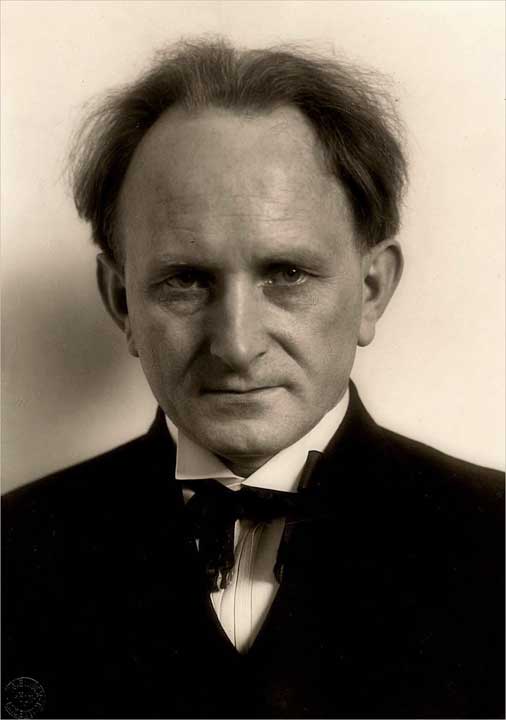
August Sander
August Sander said that photography can be described by the following three words: "See, observe, think". Following this concept, the German fine art photographer created his most important work. His collection of portraits "People of the 20th Century" made him famous. Nevertheless, we cannot limit August Sander to this work only. August Sander's work also includes landscape, nature, industrial architecture and urban photography. He is considered one of the most important and influential photographers of the 20th century for the history of portraits. His works also stand the test of time, nearly 60 years after his death.
His Life
August Sander was born on November 17, 1876, in Herdorf, Altenkirchen County, not far from Siegen (then Rhine Province, now Rhineland–Palatinate). He was the son of a mine carpenter and after finishing elementary school he worked as an unskilled laborer on the grounds of an iron mine in Herdorf. But thanks to a Siegen photographer who worked for the mining company and took August Sander as his assistant, the boy's interest in photography was triggered. With financial help from an uncle, he could buy photographic equipment and set up a laboratory. Another step on the way of his professionalization was military service (1897–1899) in Trier, where he could gain further experience as a photographer's assistant. In 1902 he married Anna Seitenmacher and in the following years they had four children. His passion for art and especially photography influenced his whole family. His daughter Sigrid Sander also had a penchant for photographs and was also active as a journalist while traveling and later permanently abroad. She immigrated to Great Britain, Iceland and finally the United States during World War II. Both of his sons, Erich and Gunther, were also interested in photography. August Sander also influenced his grandson Gerd Sander (Gunther Sander's son). During his late years, he took Gerd to take landscape photographs.
The World Wars
August belongs to a generation that experienced two world wars. It can be said that the wars influenced the life of the fine art photographer. With the outbreak of World War I, August Sander was drafted for military service in Belgium. Anna Sander continued to run the business independently during this time. After his deployment as an infantryman and hospital soldier, August Sander was transferred back to Cologne comparatively early. There he was able to continue his own work as a fine art photographer. And perhaps because he had been through the First World War, he was able to prepare himself a little better for the Second. Unfortunately, the war left a painful trauma. Due to the events of the war, the Sander couple was forced to leave Cologne. During the Nazi regime, his book, like many other works, was banned. People of the 20th Century, called Face of Time, did not glorify the master race. August Sander simply showed the Germans, including the Nazis, as they were. That is why his book was banned. From 1942 on, they gradually moved to the Westerwald village of Kuchhausen. In 1944 the Cologne studio was destroyed by bombing, but August Sander managed to save the most important part of the archive to his new place of residence. In 1934, due to his political activities (resistance activities for the SAPD), August Sander's son, Erich, was arrested and sentenced to 10 years of prison for high treason. In 1944, before the end of his sentence, he died of an untreated acute rupture of the appendix in Siegburg prison. In 1946, a fire destroyed about 25,000 to 30,000 negatives that were still deposited in the cellar near his former Cologne apartment. That same year, August Sander began an extensive photo documentation of the war-ravaged cathedral city.
His Profession
Sander was a self-taught photographer who, after working as a coal miner, became passionately involved in the medium of photography. With an encyclopedic systematic approach, he devoted himself to portrait photography, capturing archetypes of the population from the time of the Weimar Republic. He created a unique socio-psychological documentation in which he photographed social classes and occupational groups typical of the time, posed frontally in front of the camera in characteristic poses. Under the title "Antlitz der Zeit. Sechzig Aufnahmen deutscher Menschen des 20. Jahrhunderts" (Sixty Photographs of German People of the 20th Century), Sander's first book publication of the photo series appeared in 1929. Sander is considered a pioneer of factual, conceptual documentary photography, and his groundbreaking work "People of the 20th Century" impressively demonstrates why. It brings together over 600 portraits of people from various walks of life and professions. The book is divided into seven groups, which are themselves divided into a total of 45 folders. There are a total of 619 portraits in the final published book. Although well-known personalities are also depicted, only a few are mentioned by name, mostly only their profession or status. Sander died in Cologne on April 20, 1964. On a commemorative plaque located at Sander's home and studio in Cologne, Sander is personally quoted about his work: "People often ask me how I got the idea to create this work. Seeing, observing and thinking and the question is answered. Nothing seemed more suitable to me than to give a picture of our time through photography in absolute fidelity to nature."
With his collection of portraits "People of the 20th Century", August Sander has created a monumental life's work that has written photographic history and influenced generations of artists. Indeed, he has opened the doors to other well-known Siegerland fine art photographers. We can ask ourselves whether the Siegerland is the land of artists.








